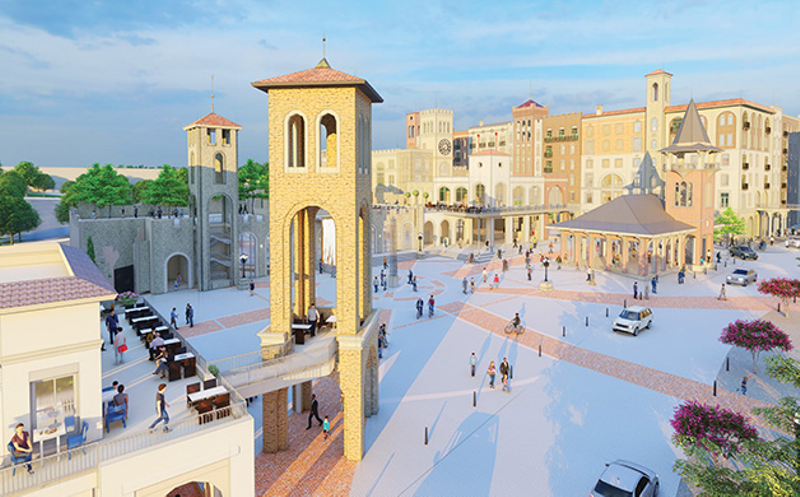
By: L.C. Leach III; Greenville Business Magazine
June 2021
It’s been called a creative village, a town within a town, a sense of place, and the wave of the future for South Carolina.
But on April 8, 2021, the city of Mauldin and Hughes Investments broke ground on the new BridgeWay Station – a multiple-phase, mixed-use development along Interstate 385 near Bridges Road that is now recognized as the Upstate’s first town center development.
Once fully completed, BridgeWay Station will carry not only its own signature look and function, it will establish a unique building model in the Upstate, and likely set a new standard for development and growth for cities all across South Carolina.
“This day has been a long time coming,” Mauldin City Councilman Taft Matney told an audience of more than 100 people at the April 8 groundbreaking. “It’s 38 years in the making, and the ceremony today is a year late.”
But the delay is expected to pay huge dividends in numerous ways.
BridgeWay Station will be built out over many years on 170 acres.
In the next 17-19 months, Phase I alone will feature six buildings, ranging from four stories to 10 stories, and carry a total build-out price tag of more than $150 million.
More than 1,000 new jobs are expected to be created in just the first phase, and thousands of other jobs will also follow in later phases.
And the entire development will allow for office, retail, restaurant, multifamily residential, a stage for performing arts, different kinds of entertainment and hotels to all exist on one site.
“BridgeWay Station is going to be like an entire town within the city of Mauldin,” said developer Phil Hughes at the groundbreaking
In addition to 500,000-plus square feet of existing, surrounding condominiums and office space, Phase I will include:
- 68,939 square feet of retail.
- 210,824 square feet of residential.
- Approximately 73,000 square feet of office.
- Approximately 81,000 square feet of institutional development.
- 24,691 square feet of plaza and pavilion public space.
“I expect BridgeWay Station to become an iconic landmark destination for people all across the state,” said Mauldin Mayor Terry Merritt. “And it’s all part of the dynamic new Mauldin landscape.”
Painting that landscape, however, required a lot of vision, a lot of planning, a lot of patience, and a lot of ongoing changes, including these four:
Beginnings
When the seeds of BridgeWay were first planted in 1983, Ronald Reagan was president, Microsoft Word was released under the name Multi-Tool Word, and Mauldin Elementary School was housed in what is now the Mauldin Cultural Center on East Butler Road.
The site for BridgeWay Station was known as Centerpointe, with only about 52 acres. Hughes said his original intention was to develop Centerpointe as another industrial property.
“The planning and grading began very soon around 1983-84, and we paused to get the plans together…”
Then he learned that a sewer moratorium had been enacted, affecting the property, and grinding the Centerpointe project to an immediate halt.
“The moratorium was a big blow at the time,” Hughes said.
But it gave him a chance to rethink Centerpointe. And after the moratorium was lifted, Hughes chose to hold the site for something better.
“Seeing the booming growth already happening in and around Mauldin, we understood that being patient as the area grows would best serve the community and Upstate with a dynamic, new mixed-use development rather than an industrial park as originally planned,” he said.
A decade passed and Hughes kept acquiring more land for Centerpointe. A second decade passed, and then a third, and land for the site kept accumulating, eventually passing the 100-acre mark.
By the time Centerpointe reached its 35th year, the property had been annexed into the city of Mauldin. Collaboration with city officials began when Hughes saw that the potential for the long-stalled development had far exceeded what he had originally conceived.
“Mauldin had by then transformed into a much more desirable place to work,” he said. “And the plan of action for what we’re getting ready to do with this land started to come together.”
Looking Back, Looking Ahead
By 2016, Centerpointe was starting to take on a life of its own, like an invisible force dictating every decision and action. It led Hughes and the city of Mauldin to implement form-based zoning, which would not only permit the site more flexibility in its uses, but also allow a focus on building form.
“The design of the buildings would be as essential as the uses,” Hughes said. “And to that end, we thought of making the entire site into something that blended old-world architecture and modern use and technology with a walking community – a new form of a town center.”
The idea was further bolstered when Greenville County and Anderson County partnered to designate the Centerpointe site as a Multi-County Industrial Park. This designation, which will last until 2045, meant in part that revenue portions distributed to the city of Mauldin would be used to pay for public improvements, such as roads and sidewalks, at CenterPointe.
The new development would also draw from local architectural elements, such as the bell tower at Furman University, the Wyche Pavilion in downtown Greenville and the old demolished Greenville Train Station.
Outdoor public space would include a mix of brick, stone, paving and green space, while still allowing vehicle access whenever necessary.
And, the site would be able to expand for years by eventually including an additional 2.5 million square feet in future development.
“There wasn’t going to be anything else like it anywhere close by,” Hughes said.
The idea already had precedent in other states, such as the King of Prussia Town Center in Philadelphia, Pa.; Virginia Beach Town Center in Virginia Beach, Va.; and a town center planned in the near future for the 22-year-old city of Sammamish, Wash.
“The plan to put a town center in place here began in 2004 as something that would help the city grow,” said Chris Hankins, senior planner for the city of Sammamish. “Like Mauldin’s earlier effort, part of our town center is also on hold because of sewer issues, and because of a building moratorium. But once all phases are finished, we think it will make Sammamish one of the best places to live in the whole state of Washington.”
Having researched other areas with town centers and seeing similar potential for Centerpointe, Hughes was now ready to proceed.
Phase I plans were finalized and a groundbreaking was scheduled for 2020.
But just as with the sewer moratorium from three decades earlier, Centerpointe was again halted – this time by a worldwide pandemic known as Covid-19.
New Bridge, New Name
Realizing the development might be another year late in starting, Hughes and Mauldin city leaders turned their attention to an item that now seemed to take on greater significance: Mauldin had long wanted to construct a pedestrian bridge from Centerpointe across Interstate-385 back into Mauldin.
But the city was also interested in connecting to the Swamp Rabbit Trail – a 22-mile, multi-use trail that had opened in 2009 along a former railroad line, stretching from Greenville Technical College to just north of the Travelers Rest city limits.
By 2020, the trail was being utilized by more than 500,000 walkers, runners and cyclists, and this number was expected to continue increasing.
The Centerpointe bridge suddenly looked like a natural connection.
“We thought it was a great idea to make the bridge an extension of the Swamp Rabbit Trail,” Taft Matney said. “So the city of Mauldin made an initial $5 million appropriation in 2019 to fund the pedestrian bridge spanning across I-385. Laurens Electric provided an easement to construct a trailhead to connect to the bridge, and in 2020, Mauldin City Council approved a $300,000 investment for its construction.”
The new multi-use bridge would be another feature that no other town center would have.
But with it, Hughes decided that after 37 years of changes and rezonings, tons of patience, and three separate periods of waiting, the Centerpointe development needed a more fitting name.
“The property was next to Bridges Road, and it would be a natural stopping point for people using the Swamp Rabbit Trail,” he said. “So the name became BridgeWay Station – as the concept of ‘bridging’ has both a practical use and a universal meaning in bringing people together.”
Legacy
Phase I for BridgeWay Station is expected to be finished in the fourth quarter of 2022.
Over the next 10 years, revenue generated to the city of Mauldin alone from just this first phase of BridgeWay Station could range from $200,000 to $800,000 per year.
“And it could even be three times that amount at full build-out,” Mayor Terry Merritt said.
The town center concept alone could influence the state’s landscape in many places in the next few decades.
And anticipation is already running high for what BridgeWay Station will mean for people in and around the Upstate.
“Think about enjoying a sporting event at Mauldin High School, then afterwards taking a stroll across the new bridge for a late-night coffee or dessert,” Merritt said.
Hughes added that he personally would like to see a 5K run, a farmer’s market and the return of the “old soap box derby.”
“There’s not one in South Carolina anymore,” he said. “And the people who run it would love to come here to BridgeWay Station and have an annual soapbox derby event.”
But regardless of the event, the work, or the use, BridgeWay Station will probably do more to make Mauldin – long known as the city without a downtown – into one of the most desired places in all of South Carolina to live or visit.
“People will be asking you one day, ‘Where’s Greenville?’” said U.S. Sen. Lindsey Graham, R-South Carolina, at the groundbreaking. “And they will say, ‘It’s near Mauldin.’”
As for getting to that day, the dirt at BridgeWay Station is now turning.
“This is a dream that came together at the right time,” Taft Matney said. “BridgeWay Station will be something that is unique to Mauldin, and we are so excited to be a part of it.”


Leave a Reply